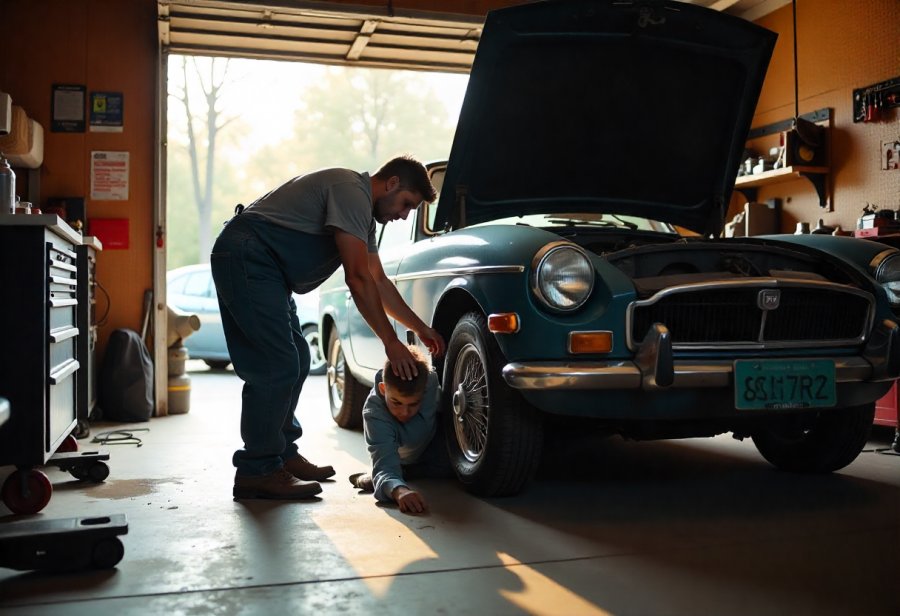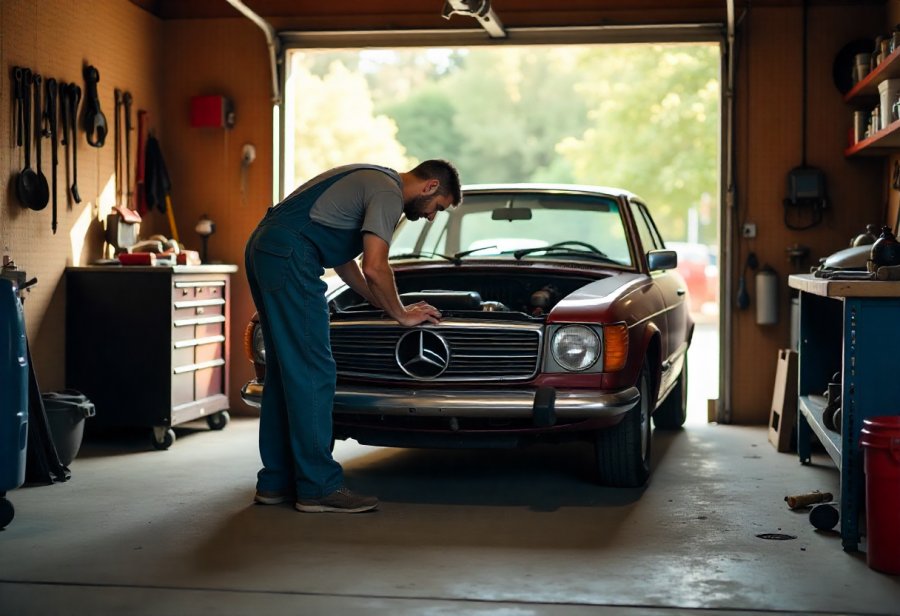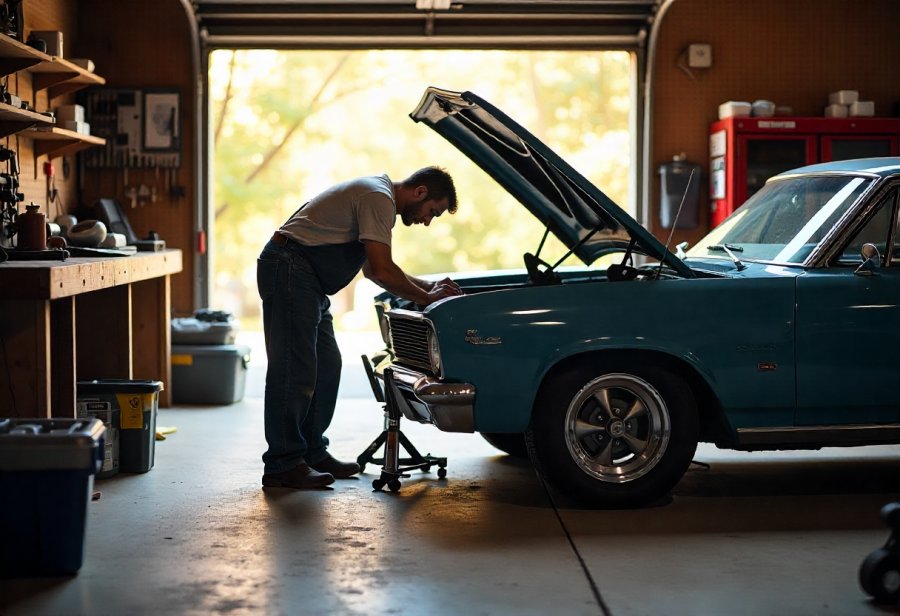Step into the captivating world of backyard mechanics, where passion, patience, and craftsmanship breathe new life into forgotten machines. This behind-the-scenes glimpse reveals the intimate rituals of restoring vintage cars—an art fueled by resourcefulness, community, and personal pride. But what secrets make these garages more than mere workspaces? From clever organization tips to hidden techniques like rust conversion and detailed documentation, the journey is filled with small revelations that elevate craftsmanship to a professional level. Today’s enthusiasts blend traditional skills with modern tools and online camaraderie, transforming their projects into stories of revival and resilience. As each vehicle is reborn, so too are skills, confidence, and community bonds. Could these humble garages hold the key to preserving automotive history—and maybe, even inspiring a new generation of passionate restorers? This world of revival is more than restoration; it’s a testament to dedication and the endless pursuit of craftsmanship.

Discover the Heart of Backyard Mechanics: A Sanctuary of Passion and Revival
There’s something quietly compelling about the world of backyard mechanics. It’s more than just tinkering with engines or restoring old cars; it’s a pursuit driven by genuine passion, patience, and a hands-on love for machines. These enthusiasts transform cluttered garages or driveways into personal workshops where rusted, forgotten vehicles are given new life through skill and dedication. Every bolt turned and every weld made is part of a story—one rooted in craftsmanship and a deep respect for the mechanical arts.
This space often becomes the heart of a home’s automotive world, a sanctuary where focus sharpens and time slows down. Shelves lined with tools, parts carefully organized, and projects in various stages create an environment that invites creativity and problem-solving. In this garage, the outside world fades away, replaced by the hum of an engine, the scent of oil, and the satisfaction of progress.
Restoring vintage machines isn’t just about appearance—it’s about preserving history and craftsmanship. Each project connects enthusiasts to a bygone era, bringing old vehicles back to life and keeping the spirit of classic engineering alive. It’s a labor of love, where patience and skill turn rust into revival, and a neglected shell transforms into a shining example of dedication.
Behind the scenes, this passion is fueled by resourcefulness and a willingness to learn. Many hobbyists pick up skills through online tutorials, forums, and mentorships, making the garage a classroom of continuous growth. Challenges like rust, missing parts, or electrical issues become opportunities to improve, learn, and push boundaries. It’s a journey marked by small victories that keep the enthusiasm alive.
A backyard mechanic’s garage isn’t just a workspace; it’s a personal sanctuary of craftsmanship and passion. It’s where old machines are reborn, stories are written, and skills are passed down. This space embodies patience, ingenuity, and a love for all things mechanical, turning each project into a meaningful chapter in a lifelong journey of revival.
Tools and Skills: Building Blocks of a Functional Vintage Garage
Backyard mechanics depend on a core set of tools and skills that turn a simple garage into a functional workshop. A well-organized toolbox is the foundation—basic hand tools like wrenches, screwdrivers, and pliers are always within reach. Over time, enthusiasts add specialty tools such as torque wrenches, pullers, or wire crimpers, which help handle specific tasks more efficiently. These tools don’t need to be expensive; what matters most is their reliability and suitability for the job.
Most skills are learned through hands-on experience, tutorials, and advice from fellow hobbyists. Many backyard restorers pick up engine repair, electrical work, and bodywork as they go, often guided by online videos or community forums. Their workspaces vary from cluttered driveways to dedicated garages, often equipped with good lighting, sturdy workbenches, and accessible storage for parts. A clean, well-lit environment makes a big difference in safety and precision, especially when working on intricate details.
The environment itself plays a crucial role. Bright LED lighting reveals rust spots, dents, or fine cracks that might otherwise be missed. Proper ventilation ensures fumes from paints, solvents, or welding don’t build up, creating a safer workspace. Many hobbyists carve out specific zones for disassembly, cleaning, and painting, which keeps projects organized and workflow smooth. This setup allows them to focus on the task at hand without unnecessary interruptions or searching for tools.
Restoring vintage vehicles is more than just mechanical work; it’s an emotional journey. Many develop a deep attachment to their projects, viewing them as links to history and craftsmanship. Each challenge—rusted parts, missing components, or electrical issues—becomes a chance to learn and grow. The patience and resourcefulness required often translate into increased confidence and problem-solving skills that spill over into everyday life.
Some hobbyists even fabricate parts when originals are unavailable, showcasing their ingenuity. Refurbishing existing components by cleaning, repairing, or modifying saves money and preserves authenticity. Documenting progress with photos or notes helps troubleshoot later and keeps the project on track. These small practices turn a restoration into a manageable, rewarding process that builds confidence and skill.
Modern technology has revolutionized home garages. Portable lifts, advanced paint sprayers, and digital diagnostics make complex tasks more accessible. Online communities provide support, inspiration, and troubleshooting advice, creating a shared space for growth. Whether restoring a classic muscle car or a vintage motorcycle, backyard mechanics blend traditional craftsmanship with modern tools, making professional results achievable in a small space.

Modern Revival: How Today’s Technology Transforms Home Restoration
Today, backyard mechanics are more connected and resourceful than ever before. The internet has transformed the hobby from solitary effort into a global community. Forums, YouTube tutorials, and social media groups provide instant access to knowledge, troubleshooting advice, and inspiration. Sharing progress and tips online fosters a sense of camaraderie that encourages more enthusiasts to dive into their projects with confidence.
Tools have also advanced significantly. Professional-grade impact wrenches, digital multimeters, and high-quality spray guns are now common in home garages. Many hobbyists invest in portable lifts and sophisticated paint sprayers, tools that once belonged only to commercial shops. These innovations allow for faster, more precise work, helping backyard restorers achieve professional results within small, often cluttered, spaces.
Despite the technological leaps, the passion for restoring vintage vehicles remains unchanged. Many enthusiasts blend traditional techniques with new equipment, customizing their setups to make their garages more efficient and inspiring. This mix of old and new keeps the hobby vibrant, appealing to both seasoned restorers and newcomers eager to learn.
Restoration styles vary widely today. Some focus on meticulous, concours-quality rebuilds, while others prefer quick cosmetic fixes that freshen up a vehicle’s appearance. Regional differences influence project scope, with urban garages leaning toward speed and efficiency, and rural setups accommodating larger, more ambitious builds. Yet, the core love for vintage cars and craftsmanship unites this diverse scene.
The rise of online communities fuels a culture of sharing and mentorship. Hobbyists post detailed tutorials, progress photos, and troubleshooting tips, inspiring others to start or improve their own projects. This digital camaraderie makes it easier than ever for beginners to learn and for experts to exchange ideas, reinforcing the idea that restoration is as much about community as it is about the car.
Modern technology also introduces new opportunities. Laser alignment tools, eco-friendly paints, and even 3D printing expand what’s possible in a backyard setup. These tools help amateurs achieve results that rival professional shops, turning complex tasks into manageable projects.
The evolving landscape of backyard mechanics keeps the hobby dynamic and accessible. It’s no longer just about fixing old cars; it’s about reviving history, sharing skills, and building a community rooted in craftsmanship. As more people embrace this passion, the garage remains a place of continual learning, innovation, and revival.
This fusion of traditional craftsmanship and cutting-edge tools is shaping the future of home restoration. For those interested in exploring the latest innovations, learning more about modern restoration techniques can be incredibly beneficial. To discover how contemporary technology is transforming the hobby, check out this article on modern restoration technology.
Smart Budgeting: Managing Costs in Your Garage Restoration Journey
Restoring vintage vehicles in a home garage can be incredibly rewarding, but it also demands careful financial planning. Costs can quickly mount, especially when sourcing rare parts or investing in specialized tools. Without a clear budget, expenses tend to spiral, turning what should be a fun hobby into a financial strain. Prioritizing essential purchases and setting limits helps keep projects manageable and prevents surprises along the way.
Investing in quality tools pays off over time, even if the initial outlay is significant. Impact wrenches, paint sprayers, and digital multimeters might seem costly upfront, but they enhance efficiency and precision, leading to a better finish and less rework. Focusing on versatile, durable tools ensures they last through multiple projects, spreading out the expense and increasing value. This strategic approach helps hobbyists stay within budget while achieving professional-looking results.
Smart sourcing of parts makes a big difference. Salvage yards, online marketplaces, and community swaps often offer more affordable options, especially for hard-to-find or original components. Refurbishing or repairing existing parts—like cleaning or minor fixes—can save money and add authenticity. Developing DIY skills for small repairs and electrical work not only cuts costs but deepens understanding, making future projects easier and more cost-effective.
Unexpected expenses are part of the process. Rusted structural elements, missing components, or hidden damage often surface mid-project. Keeping a detailed budget, tracking spending, and maintaining a contingency fund prevent these surprises from derailing progress. Patience and resourcefulness become key, turning unforeseen costs into opportunities to learn and adapt without breaking the bank.
While the financial investment can seem daunting, many backyard restorers find the personal satisfaction outweighs the costs. The skills gained, the memories created, and the joy of breathing new life into a vintage machine make it worthwhile. By practicing disciplined budgeting, leveraging community advice, and making strategic choices, enthusiasts can enjoy their passion without financial regret, transforming their garage into a true workshop of revival.
From Garage to Life: Real-World Success Stories That Inspire
Restoring vintage machines in the garage often extends beyond the work itself, making a real difference in everyday life. For many backyard mechanics, rolling up their sleeves on a project offers a much-needed break from screens and daily stresses. The focus required to revive a neglected vehicle creates a sense of purpose and achievement that boosts confidence and motivates other areas of life. Seeing an old, rusted shell transform into a shining, functioning vehicle becomes a tangible reminder that patience and effort pay off.
Stories of success in this scene are plentiful and inspiring. Take Mike, who stumbled upon a forgotten muscle car in a neighbor’s shed. Over months of dedicated effort, he disassembled, cleaned, and reassembled every component. When it roared back to life, it wasn’t just a win for him; it sparked pride among friends and neighbors, turning his garage into a hub of activity and shared joy. These projects often turn into weekend rituals, strengthening bonds and creating stories that last long after the car hits the road.
Completing tough repairs—like electrical fixes or fabricating missing parts—does more than fix a vehicle. It reinforces problem-solving skills and patience, qualities that spill over into everyday challenges. The pride gained from these accomplishments builds resilience and a proactive mindset, showing that setbacks can be stepping stones rather than barriers. These small victories become confidence boosters, inspiring others to start their own projects and embrace the craftsmanship involved.
Beyond individual achievement, garage restorations foster community connections. Sharing progress online or at local meetups sparks motivation and spreads knowledge. Newcomers see what’s possible and are encouraged to take on their own projects, creating a ripple effect of skill-sharing and enthusiasm. This culture of collaboration turns the garage from a solitary workspace into a lively, supportive community rooted in craftsmanship and shared passion.
For many hobbyists, these projects become a core part of their lifestyle, shaping how they approach challenges and celebrate successes. The garage evolves into a sanctuary of growth, where each restored vehicle is a badge of patience and ingenuity. These stories of revival—whether a vintage car or motorcycle—highlight the deep personal and community impact of garage restoration, fueling the passion to keep these mechanical legacies alive and thriving.

Garage Secrets Unveiled: Insider Tips to Elevate Your Restoration Game
One of the most overlooked secrets in garage restoration is how much a simple system of organization can save time and frustration. Labeled containers for small parts, magnetic strips on the wall, and dedicated tool stations make finding that elusive bolt or screwdriver effortless. When everything has its place, you spend less time hunting and more time working, allowing projects to flow smoothly from start to finish.
Pre-assembling components outside the vehicle is another trick many pros swear by. For example, assembling brake calipers or carburetors off the car in a clean, well-lit space speeds up the process and reduces errors. This small step turns a complicated task into a straightforward one, especially in tight spots or hard-to-reach areas, saving hours of fiddling in awkward positions.
Rust conversion is a hidden gem that can preserve metal integrity without costly repairs. Instead of abrasive blasting, using rust converters or phosphoric acid stabilizes corrosion and prepares surfaces for paint. This approach not only extends the lifespan of parts but also keeps the project moving forward without delays caused by extensive metal work.
Documenting your progress with photos or notes might seem tedious, but it’s a game-changer. Clear records help troubleshoot issues later, source the right parts, and keep the project on track. Plus, they create a visual story of your work, which can be motivating and immensely helpful if you decide to share your build online or pass it down.
Pay attention to airflow and lighting—simple tweaks that make a huge difference. Bright, even LED lighting reveals flaws and fine details, preventing missed spots or mistakes. Good ventilation ensures fumes from paints, solvents, and welding don’t accumulate, making the workspace safer and more comfortable, so you can focus on the task at hand.
Mastering small techniques like proper surface prep, using quality primers, and applying thin coats of paint can elevate your final results dramatically. These details often separate a good restoration from a professional-looking finish. When combined with patience and resourcefulness, they transform a basic project into a true masterpiece.
In the end, these lesser-known tips and secrets turn a routine rebuild into a more efficient, enjoyable journey. They help you work smarter, not harder, and elevate your craftsmanship from good to great. With a little insight and organization, your garage projects become not just restorations, but personal achievements that stand the test of time.







